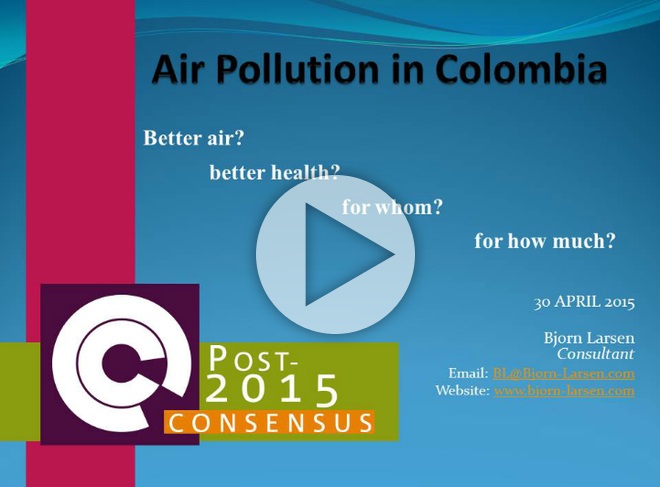Colombia Perspective: Air Pollution
Click here for information in spanish.
Background
According to a study for the World Bank[i], air pollution kills 15,000 Colombians every year. But only about 8,000 of these deaths are from the outdoor pollution that we normally worry about, particularly in cities. 7,000 result from household air pollution, caused by cooking and heating with wood and other solid fuels. This affects mainly rural communities.
In both cities and countryside, the cause is the same: tiny particles in smoke which we breathe in and which can lead to chronic lung disease and acute respiratory infections, lung cancer, heart disease and strokes. This does not just affect Latin America, but is a global problem causing over 6 million deaths worldwide each year.[ii]
In Colombia, outdoor air pollution is a real problem, causing about one in 20 of all deaths in the metropolitan areas of Bogota, Valle de Aburra and Cali. But for rural dwellers the situation is much worse; household air pollution is responsible for an alarming 17% of all deaths. More than one in every six deaths is caused by burning wood and solid fuels to cook food and keep warm.
The most dangerous of the airborne particle are known as PM2.5 (particulates less than 2.5 thousandths of a millimetre across) which can penetrate deep into the lung. The World Health Organization (WHO) has set a limit for average outdoor ambient air pollution of 10 micrograms (10 millionth of a gram) of PM2.5 per cubic metre of air (10 µg/m3). In urban areas, the level may be twice this, and over 60% of the Colombian population is estimated to breathe air which is more polluted than the WHO guideline[iii].
6 million Colombians – half of all rural households – rely on solid fuels and many others use them as part of their fuel mix. For these households, mainly in the Caribe, Central and Pacifica regions, air pollution is often at least ten times higher than in towns and cities. For the person cooking, average concentrations of PM2.5 breathed day and night are in the range of 11 to 26 times the WHO guideline, a really shocking statistic.
Replacing open fires and traditional stoves with improved cookstoves with chimneys – and maintaining them well - reduces this exposure by half, but the average remains about 80µg/m3, still eight times the recommended limit. To make greater improvements, households need to make the transition to the more expensive propane (LPG). Use of gas as the primary fuel is a key reason why urban households are less polluted. If all rural households used LPG, pollution may decline to 25µg/m3 or less, but exposure would be perhaps double that if only a fraction of households changed.
Adoption of improved cookstoves would reduce the risk of disease and death by 30%. Going further and using LPG would reduce disease and death by 45-65%.
Improved cookstoves in Colombia are relatively expensive but there is no reason why they should not be modelled on the successful examples of Mexico, Peru, Guatemala and other countries in the region[iv]. Costs there are in the region of 250-400 thousand Pesos, and they burn only about half the amount of wood used in traditional stoves, so there are savings on fuel costs. On the other hand LPG stoves can cost half a million Pesos, and the fuel can cost a further 350 thousand Pesos a year. For both cases, the benefits in health, fuel savings and time more than outweigh the cost.
But the transition to use of gas cannot happen overnight because not all families can afford the cost. A reasonable interim target is to convert half of the households burning solid fuel to improved stoves with a chimney and the other half to LPG stoves. This would reduce the incidence of death and illness by over a third and save 2,750 lives a year. Every thousand Pesos spent on improved stoves would pay back 9,000 Pesos in benefits, while a thousand Pesos spent on LPG stoves would give benefits worth at least 2,500 Pesos. Both would make a real improvement to people’s lives.
Converting all households to LPG would save 4,700 deaths a year and reduce disease and death by two thirds. The annual cost would be 673 billion Pesos, but the benefits would be worth three times as much.
The air in many of Colombia’s cities is much cleaner than it used to be, but there is still some way to go to reach even the interim WHO air quality standard of 15µg/m3. However, achieving this would be far more expensive than investing in cleaner cooking facilities for rural households. In doing this, it is important to involve whole communities so that pollution is reduced for all households.
[i] Larsen, B., and Skjelvik, J.M. 2014. Environmental health in Colombia: An economic assessment of health effects and their costs. Prepared for the World Bank. Washington, D.C., USA.
[ii] Lim, S.S., Vos, T., Flaxman, A.D., Danaei, G., et al. 2012. A comparative risk assessment of burden of disease and injury attributable to 67 risk factors and risk factor clusters in 21 regions, 1990-2010: a systematic analysis for the Global Burden of Disease Study 2010. Lancet, 380: 2224-60, and http://www.who.int/mediacentre/news/releases/2014/air-pollution/en/
[iii]See i.
[iv] Berrueta, V., Edward, R., and Masera, O. 2008. Energy performance of wood-burning cookstoves in Michoacan, Mexico. Renewable Energy, 33(5), 859–870.


